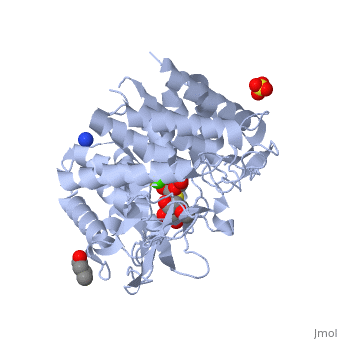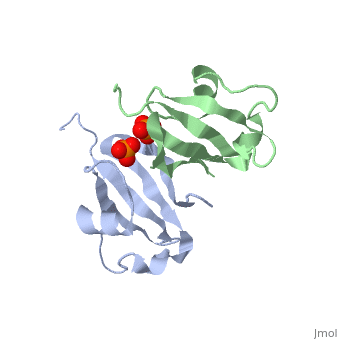Cyclin-dependent kinase regulatory subunit: Difference between revisions
Jump to navigation
Jump to search
Michal Harel (talk | contribs) No edit summary |
Michal Harel (talk | contribs) No edit summary |
||
| Line 1: | Line 1: | ||
<StructureSection load='1dks' size='340' side='right' caption='Human CKS 1 complex with phosphate (PDB code [[1dks]])' scene=''> | <StructureSection load='1dks' size='340' side='right' caption='Human CKS 1 complex with phosphate (PDB code [[1dks]])' scene=''> | ||
{{STRUCTURE_1x9d| PDB=1x9d | SIZE=300| SCENE= |left| CAPTION=Human α-mannosidase class I complex with mannopyranoside, sulfate, 1,4-butanediol, Ca+2 ion, [[1x9d]] }} | |||
'''Cyclin-dependent kinase regulatory subunit''' (CKS) is a small protein which is essential for the functioning of CDK-cyclin complex. CKS binds to the catalytic subunit of CDK see complex structure in the figure at top left. CKS1 is essential for CDK5 functioning in neuronal diferentiation. CKS exists as hexamer of homodimers and can bind six kinase molecules. | '''Cyclin-dependent kinase regulatory subunit''' (CKS) is a small protein which is essential for the functioning of CDK-cyclin complex. CKS binds to the catalytic subunit of CDK see complex structure in the figure at top left. CKS1 is essential for CDK5 functioning in neuronal diferentiation. CKS exists as hexamer of homodimers and can bind six kinase molecules. | ||
== Function == | == Function == | ||
Revision as of 10:32, 12 October 2015
Cyclin-dependent kinase regulatory subunit (CKS) is a small protein which is essential for the functioning of CDK-cyclin complex. CKS binds to the catalytic subunit of CDK see complex structure in the figure at top left. CKS1 is essential for CDK5 functioning in neuronal diferentiation. CKS exists as hexamer of homodimers and can bind six kinase molecules. FunctionDiseaseRelevanceStructural highlights |
| ||||||||||||||||||||||||||||||||||||||||||||||||||
3D Structures of cyclin-dependent kinase regulatory subunit3D Structures of cyclin-dependent kinase regulatory subunit
Updated on 12-October-2015


